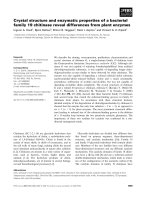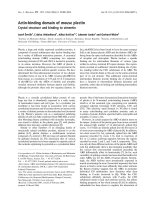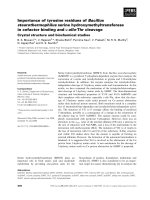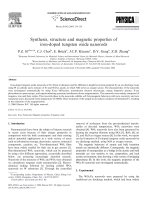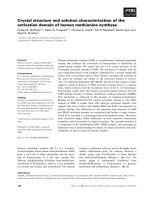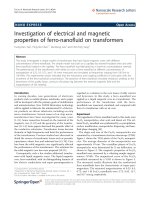Crystal Structure and Magnetic Properties of TbTSn Compounds (T = Pt and Rh)
Bạn đang xem bản rút gọn của tài liệu. Xem và tải ngay bản đầy đủ của tài liệu tại đây (357.68 KB, 5 trang )
<span class='text_page_counter'>(1)</span><div class='page_container' data-page=1>
32
Crystal Structure and Magnetic Properties of TbTSn
Compounds (T = Pt and Rh)
Ho Thi Doan
1, Vuong Van Hiep
1, Nguyen Khac Thuan
2, Do Thi Kim Anh
1,*<i>1</i>
<i>Faculty of Physics, VNU University of Science, 334 Nguyen Trai, Hanoi, Vietnam </i>
<i>2</i>
<i>Faculty of Engineering Physics and Nanotechnology, VNU University of Enginerring and Technology, </i>
<i>144 Xuan Thuy, Cau Giay, Hanoi, Vietnam </i>
Received 17 May 2018
Accepted 28 May 2018
<b>Abstract: The TbTSn compounds (T = Pt, Rh) have been prepared by arc-melting in purified Ar </b>
atmosphere. Crystal structures were studied by X-ray powder diffraction. The Rietveld analysis
shows the single phase in hexagonal ZrNiAl-type structure for TbPtSn and TbRhSn compounds.
Magnetic properties and specific heat measured by mean of Physical Properties Measurement
<i>System (PPMS) demonstrated the phase magnetic transition at Néel temperature T</i>N.
<i>Keywords: Crystal structure, Magnetic properties. </i>
<b>1. Introduction</b>
The crystal structure, specific heat and magnetic properties of the equiatomic ternary compounds
of RMX have been studied (R = rare earth, M = transition metal and X = Si, Ge, Al, In and Sn) [1-3].
Ternary equiatomic rare-earth R = Ce, Pr, Nd compounds RMX crystallized in the orthorhombic
TiNiSi-type structure (space group: Pnma) [4]. Among the RMX compounds, Tb compounds TbNiSn
and TbRhGe exhibit strongly anisotropic physical properties reflecting their crystal symmetry. The
existence of successive magnetic transitions with temperature as well as the multistep metamagnetism
under high field has been clarified for TbNiSn and TbRhGe single crystals [5–10]. For another
isostructural compound TbPdSn, the results of bulk magnetic measurements on polycrystalline
samples have been reported so far [11–13]. In this studies, we present crystal structure, specific heat
and magnetic properties of TbPtSn, TbPdSn, TbNiSn compounds at low temperature.
_______
Corresponding author. Tel.: 84-904543849.
Email:
</div>
<span class='text_page_counter'>(2)</span><div class='page_container' data-page=2>
<b>2. Experimental </b>
The TbPtSn and TbRhSn alloys were prepared from the pivot elements Tb, Pt, Rh 99.9% (3N) and
Sn of 99.99% (4N) by using an arc-melting method in the argon atmosphere. The crystal structure
<i>characterization was analyzed by the X-ray diffractometer Rigaku Rint-2000 with CuKα1</i> radiation
<i>with wavelength λ = 1.54059 Å. The analysis of phases was processed by mean of the Rietveld profile </i>
fitting method as discussed in Ref. [14]. The Superconducting Quantum Interference Device
magnetometer (SQUID, Quantum Design) was used to obtain the results of magnetization in the
temperature range from 1.8 to 300 K and the field up to 7 T. The specific heats were measured by
using a PPMS system in the temperature range from 2 to 30 K.
<b>3. Results and discussions </b>
Fig.1. The X-ray diffraction patterns of TbRhSn compounds.
The purity of phase of compounds was checked by X-ray analysis. Figure 1 shows the XRD
patterns of TbRhSn compound. It can be seen clearly that the compound exhibits an excellent phase
quality. The phase was indexed as hexagonal ZrNiAl type structure (space group P 2m) for TbPtSn
and TbRhSn compounds. Further analysis of phase by Rietveld method for TbRhSn showed that the
Tb atoms occupied 3g positions (x1,0,1/2; 0,x1,1/2; , ,1/2) and the Sn atoms 3f positions (x2,0,0;
0,x1,0; , ,0), while the Pt atoms the 2c positions (1/3,2/3,0; 2/3,1/3,0), and 1b (0,0,1/2). The
analysis resulted for TbRhSn x1 = 0,5886, x2 <i>= 0,2541 and lattice constant a = b = 7.44378 Å, </i>
<i>c = 3.99993 Å. </i>
</div>
<span class='text_page_counter'>(3)</span><div class='page_container' data-page=3>
<b>0</b> <b>50</b> <b>100</b> <b>150</b> <b>200</b>
<b>0.0</b>
<b>0.2</b>
<b>0.4</b>
<b>0.6</b>
<b>0.8</b>
<b>1.0</b>
0
2000
4000
6000
8000
10000
<b>T (K)</b>
<b>M</b>
<b> (</b>
<b>em</b>
<b>u</b>
<b>/g)</b>
<b>H = 1000 Oe</b>
<b>TbPtSn compound</b>
<b>T<sub>N</sub></b>
<b>T<sub>1</sub></b>
<b>−1</b> <b> (</b>
<b>O</b>
<b>e g</b>
<b>/e</b>
<b>m</b>
<b>u</b>
<b>)</b>
p = − 9.7 K
<b>0</b> <b>50</b> <b>100</b> <b>150</b> <b>200</b>
<b>0.0</b>
<b>0.2</b>
<b>0.4</b>
<b>0.6</b>
<b>0.8</b>
<b>1.0</b>
<b>1.2</b>
<b>1.4</b>
0
2000
4000
6000
8000
<b>T (K)</b>
<b>M</b>
<b> (</b>
<b>e</b>
<b>m</b>
<b>u/</b>
<b>g)</b>
<b>H = 1000 Oe</b>
<b>TbRhSn compound</b>
<b>TN</b>
<b>T1</b>
<b>−1</b> <b> (</b>
<b>O</b>
<b>e</b>
<b> g/</b>
<b>e</b>
<b>m</b>
<b>u</b>
<b>)</b>
p = − 7.4 K
<b>0</b> <b>10</b> <b>20</b> <b>30</b> <b>40</b> <b>50</b>
<b>0.0</b>
<b>0.2</b>
<b>0.4</b>
<b>0.6</b>
<b>0.8</b>
<b>1.0</b>
<b>1.2</b>
<b>1.4</b>
<b>Temperature (K)</b>
<b>M</b>
<b>agn</b>
<b>et</b>
<b>iz</b>
<b>at</b>
<b>ion (</b>
<b>em</b>
<b>u</b>
<b>/g)</b>
<b>H = 1000 Oe</b>
<b>TbTSn compounds</b>
<b>T = Pt</b>
<b>T = Rh</b>
<b>TN</b>
<b>TN</b>
<b>T1</b>
</div>
<span class='text_page_counter'>(4)</span><div class='page_container' data-page=4>
Figure 2 shows the temperature dependence of the magnetization and the inverse magnetic
<i>susceptibility of TbPtSn and TbRhSn compounds at H = 1000 Oe. In the M(T) curves, there are two </i>
anomalies indicative of successive magnetic transitions. A antiferromagnetic ordering takes place at
<i>T</i>N = 13.5 K for TbPtSn compound and 19.6 K for TbRhSn compound. A further increase is observed
in the magnetization below 5 K for all compounds. The temperature dependence of magnetic
susceptibility in magnetic feld of 1000 Oe was described by a modified Curie-Weiss law: <i>(T) = </i>0 +
<i>C/(T - </i>P). In the paramagnetic phase the inverse susceptibility obeys a modified Curie Weiss law with
the paramagnetic Curie P = - 9.7 K for TbPtSn compound and P = - 7.4 K for TbRhSn compound.
<i>Figure 3 shows the plot of specific heat C</i>p<i> versus temperature T for TbPtSn compound. The two </i>
<i>jumps in the specific heat are observed at corresponding temperatures T</i>N<i> = 13.5 K and T</i>t<i> = 5 K, </i>
respectively. The anomaly at 13.5 K should be the paramagnetic to antiferromagnetic state. The latter
anomaly should be order-order transition. The total specific heat was assumed to be composed of three
parts: electron, lattice and magnetic contributions. Here, the electronic part was neglected. The main
issue was to evaluate the lattice part in the magnetic compound [16].
<b>0</b> <b>5</b> <b>10</b> <b>15</b> <b>20</b> <b>25</b> <b>30</b>
<b>0</b>
<b>5</b>
<b>10</b>
<b>15</b>
<b>20</b>
<i><b>C</b></i><b>p</b>
<b> (</b>
<b>J</b>
<b>/m</b>
<b>o</b>
<b>l </b>
<b>K</b>
<b>)</b>
<i><b>T (K)</b></i>
<b>TbPtSn</b>
<b>T<sub>N</sub></b>
<b>T<sub>t</sub></b>
Fig. 3. Specific heat versus temperature for TbPtSn compound.
A model for the magnetic structure change at Tt is suggested to account for the anomalies found in
the magnetization and specific heat.
<b>4. Conclusion </b>
</div>
<span class='text_page_counter'>(5)</span><div class='page_container' data-page=5>
<b>Acknowledgements</b>
This research is funded by Vietnam National Foundation for Science and Technology
Development (NAFOSTED) under grant number 103.02 -2017.326.
<b>References </b>
[1] A. Szytula, and J. Leciejewicz, Handbook of the Crystal Structure and Magnetic Properties of Rare Earth
Intermetallics, CRC, Boca Reton, 1994, pp.83-98.
[2] P. Rogl, Handbook of Physics and Chemistry of Rare Earth, eds. K.A. Gschneider Jr. and L. Eyring
North-Holland, Amsterdam, 1984, Vol. 7, p. 1.
[3] T. Fujita, T. Suzuki, S. Nishigori, T. Tahabakete, H. Fujii and J. Sakurai, J. Magn. Magn. Mater. 108, 35 (1992).
[4] C.D. Routsi, J.K. Yakinthos, and E. Gammari-Seale, J. Magn. Magn. Mater. 110, 317 (1992).
[5] M. Kurisu, H. Hori, M. Furusawa, M. Miyake, Y. Andoh, I. Oguro, et al., Physica B 201 (1994) 107.
[6] Y. Andoh, M. Kurisu, S. Kawano, Physica B 237–238 (1997) 575.
[7] S. Kawano, Y. Andoh, M. Kurisu, J. Phys. Chem. Solids 60 (1999) 1205.
[8] M. Kurisu, R. Hara, G. Nakamoto, M. Furusawa, H. Hori, S. Kawano, et al., Rev. High Pressure Sci. Technol. 7
(1998) 550.
[9] M. Kurisu, G. Nakamoto, T. Nobata, T. Ida, T. Tsutaoka, Y. Andoh, et al., KURRI Prog. Rep. 43 (1999) 13.
[10] M. Kurisu, G. Nakamoto, T. Himi, Y. Andoh, T. Tsutaoka, S. Kawano, Activity Rep. Neut. Scatt. Res., ISSP
Univ. Tokyo 8 (2001) 147.
[11] J. Sakurai, Y. Yamaguchi, K. Mibu, T. Shinjo, J. Magn. Magn. Mater. 84 (1990) 157.
[12] D.T. Adroja, S.K. Malik, Phys. Rev. B 45 (1992) 779.
[13] M. Guillot, A. Szytu"a, Z. Tomkowicz, R. Zach, J. Alloys Comp. 226 (1995) 131.
[14] H. M. Rietveld: Acta Crystallogr. 22 (1967) 151.
[15] A. Szytula, M. Kolenda, J. Leceijewicz, and N. Süsser, J. Magn. Magn. Mater. 164, 377 (1996).
</div>
<!--links-->

